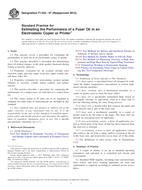Potrebujeme váš súhlas na využitie jednotlivých dát, aby sa vám okrem iného mohli ukazovať informácie týkajúce sa vašich záujmov. Súhlas udelíte kliknutím na tlačidlo „OK“.
ASTM F1434-97(2013)
Standard Practice for Estimating the Performance of a Fuser Oil in an Electrostatic Copier or Printer (Withdrawn 2020)
Automaticky preložený názov:
Štandardné praktiky pre odhad výkonnosť fixačné olej v elektrostatickom kopírku či tlačiareň
NORMA vydaná dňa 1.4.2013
Informácie o norme:
Označenie normy: ASTM F1434-97(2013)
Poznámka: NEPLATNÁ
Dátum vydania normy: 1.4.2013
Kód tovaru: NS-50276
Počet strán: 5
Približná hmotnosť: 15 g (0.03 libier)
Krajina: Americká technická norma
Kategória: Technické normy ASTM
Kategórie - podobné normy:
Anotácia textu normy ASTM F1434-97(2013) :
Keywords:
electrostatic copier, fuser agent, fuser oil, silicone fluid, ICS Number Code 37.100.10 (Reproduction equipment)
Doplňujúce informácie
| Significance and Use | ||||||||||||
|
5.1 This practice can be used to evaluate the performance of different fuser oils in a specific model copier or printer. 5.2 This practice can be used to evaluate a subject fuser oil in comparison to an acceptable control fuser oil. 5.3 This practice can be used to estimate the consumption of a specific fuser oil in a copier or printer. 5.4 This practice can be used with recirculating systems to monitor the change in volatile matter content as the test progresses. An excessive increase in volatile matter content can indicate breakdown of the fuser oil due to the combined effect of the heat of the fuser unit and the catalytic action of contaminants introduced by toner, paper, and other materials encountered in the machine. The production of excessive amounts of volatile materials may damage delicate electrical components within some copying machines. 5.5 This practice can be used with recirculating systems to monitor the change in viscosity as the test progresses. An excessive increase in the viscosity of a fuser oil can indicate that it is beginning to form a gel due to the effect of oxygen, contaminants, and high temperatures encountered in the machine. 5.6 This practice can be used with recirculating systems to monitor the change in surface tension as the test progresses. An increase in surface tension indicates loss of the release properties of the fuser oil and may lead to print offsetting and other adverse effects. 5.7 This practice can be used to evaluate the rate of fuser oil-related buildup on the fuser roll. A rubbery material that consists of gelled fuser oil, paper dust, toner, and other contaminants may build up on the fuser roll as the fuser oil degrades. Inspection of the fuser roll at specific intervals provides a qualitative evaluation of this effect. 5.8 This practice can be used to determine changes in measured print quality, odor emission, paper jam rate, paper wrap rate, paper crinkle rate, and fuser roller life during the test. 5.9 This practice is a single estimate subject to a significant number of variables that are not measured easily. Consequently, a repeated number of tests on more than one machine will yield more reliable conclusions. 5.10 This practice may be used with recirculating systems to establish limits for acceptable change in physical properties based on data correlations. Such limits may provide more efficient evaluation of sample fuser oils and prevent damage to the copying machine by avoiding the need to test to failure. |
||||||||||||
| 1. Scope | ||||||||||||
|
1.1 This practice covers a procedure for estimating the performance of fuser oil in an electrostatic copier or printer. 1.2 This practice describes a procedure for determining fuser oil-related changes in the print quality measured during testing at specific intervals. 1.3 Properties evaluated for all systems include odor emission, paper jam rate, paper wrap rate, paper crinkle rate, and fuser roller life. 1.4 Properties evaluated for recirculating systems include changes in viscosity, volatile matter content, and surface tension. 1.5 This practice describes a procedure for comparing the performance of a subject fuser oil with that of a control fuser oil. 1.6 The values stated in SI units are to be regarded as standard. No other units of measurement are included in this standard. 1.7 This standard does not
purport to address all of the safety concerns, if any, associated
with its use. It is the responsibility of the user of this standard
to establish appropriate safety and health practices and determine
the applicability of regulatory limitations prior to use.
Standard Test Method for Kinematic
Viscosity of Transparent and Opaque Liquids (and Calculation of
Dynamic Viscosity) Standard Test Method for Volatile Matter
in Silicone Fluid Standard Test Method for Measuring
Viscosity at High Temperature and High Shear Rate by Tapered-Plug
Viscometer Standard Test Methods for Surface and
Interfacial Tension of Solutions of Paints, Solvents, Solutions of
Surface-Active Agents, and Related Materials Standard Practice for Estimating Toner
Usage in Copiers Utilizing Dry Two-Component Developer (Withdrawn
2017) Standard Terminology Relating to
Electrostatic Copying |
Odporúčame:
Aktualizácia zákonov
Chcete mať istotu o platnosti využívaných predpisov?
Ponúkame Vám riešenie, aby ste mohli používať stále platné (aktuálne) legislatívne predpisy
Chcete vedieť viac informácií ? Pozrite sa na túto stránku.




 Cookies
Cookies
